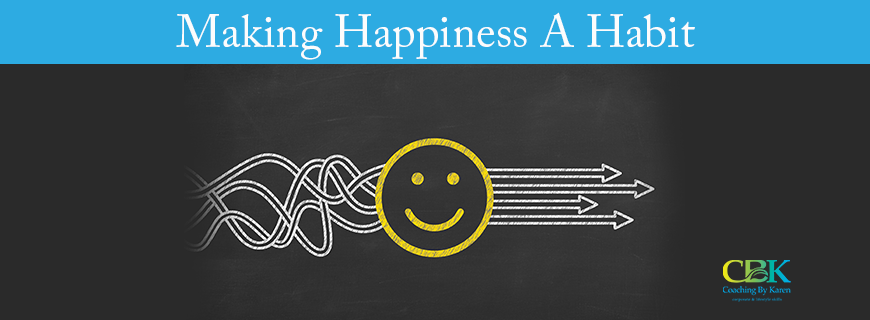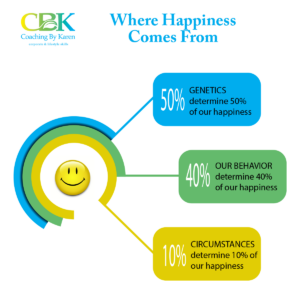Making Happiness A Habit

Are you happy? Stop reading for a moment and take your happiness temperature – how happy are you on a scale of 1-10, where 10 is Super Happy?
Here’s another question – would you say that you are a happy person on a regular basis? Or, do you feel like most people are pretty happy and you’re not?
It might surprise you to know that only 31% of surveyed Americans reported that they were happy. That means two thirds of our society are unhappy – that’s a majority! The question you may be asking is WHY? Why aren’t more people happy? Is life too hard? Are there just too many bad things in the world? Or, are most people simply unaware or unable to achieve a life that makes them happy?
To find an answer, we need to look at our potential for happiness. Science is telling us that personal happiness comes from three sources: 
- 50% = Genetics
- 10% = Circumstance
- 40% = Our Behaviors/Reactions – Intentional activities
Genetically speaking, scientists have identified 3 genes related to happiness, not to mention other physical influencers such as clinical depression and neurosis. So, if you have a tendency for depression in your family genes, there’s a good chance that your mood will be influenced by those genes. And, if you come from a happy family, you are more likely to be positive and happy, too. While 50% may seem like a lot of influence on your happiness, don’t get depressed… there’s more to look at!
Our circumstances in life are said to affect only 10% of our happiness, and yet, we place a lot of our happiness power on trying to achieve things we THINK will make us happy. We tell ourselves that once we get “this” we will be happy forever. “This” may be a college degree, a raise, a spouse, a new home, losing 20 pounds, etc. The problem is, happiness that comes from circumstance is only temporary. Most people find that even after they marry the perfect spouse, or get the new job, they still aren’t as happy as they thought they would be, and they create a new list of things they think they need to acquire in order to be happy. They get those things and over time the cycle continues without them ever achieving the happiness they seek.
So, you may be wondering how can we find/create/be happy when our genes may be working against us, and our happiness from “stuff” and events is fleeting? The answer is the other 40% – our behaviors and reactions. And, frankly, I have found that by strengthening our behavior and reaction skills, not only can we affect the 40%, we can influence and even over-power the other 60%.
True happiness is not based on where we come from, what we have, or what we want. True happiness, as cliché as it sounds, comes from within. Happiness is a reaction to the life around us. A reaction is defined as a “physical and mental response to external stimuli.” Therefore, happiness is based on what we think, and how we act.
Think about that for a moment – Happiness is based on what we think and how we act. When we look at things from a negative perspective, we become unhappy. When something “bad” happens and we replay the event over and over in our head, we become unhappy. For some people, this replaying of negative thoughts becomes a habit and gets applied to the majority of their life. If you have more negative thoughts than positive, of course you are going to be unhappy. So, how do we change that? We must break the “unhappiness habit.”
“Most of us are just about as happy as we make up our minds to be.” ~William Adams
Years ago, I was a Trainer and Program Facilitator for a smoking cessation program. As a habit, smoking is one of the most difficult to break, and yet, I worked with many people who are now ex-smokers. The program focused on teaching people skills that they could use to overcome their smoking habit by addressing two key areas: 1) Find new ways of looking at their habit that would inspire them to change their behaviors and reactions, 2) Identify new, healthier activities that take the place of smoking a cigarette.
For people caught up in the “unhappiness habit,” developing skills that help them change their perspective, stop the negative thoughts, and respond in a positive manner can turn a less-than-happy life into one that increases personal happiness as well as the happiness in people around them. And while many books and blogs may offer some suggestions on how to be happier, each of us must find our own internal motivation to change how we look at and approach the difficulties we experience in life.
So, how do we find our internal motivation? We start by determining how important our own happiness is to us, and then by looking at what makes us happy and what makes us unhappy. Then, we do more of what makes us happy, and figure out how to change the way we look at and respond to the things that don’t add to our happiness.
For a few people, being happy is just who and what they are. But, for most of us, it is something that comes from engaging in things we enjoy, giving up the things that make us unhappy, and learning to react positively when things don’t go the way we want.
You may be thinking that learning to be happy takes too much work… but, consider the alternative. You deserve a happy, fulfilling, successful life, and you have the power to make that happen!
——-
If you aren’t part of the 31% who generally feels happy, you can start breaking your unhappy habit with a few tools from my “Unhappiness cessation program” found here:
- Free Download: 16 Things To Give Up For Happiness
- Free Download: Finding Your Happiness Workbook
- Recommended CBK Videos –
- Making Happiness A Habit
- Feel Better Now
- Positively Positive
- Personal Freedom

